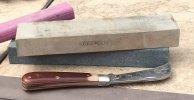Thanks for posting this video as well. I have yet to pull the trigger on the AF, as I have too many stones already! Is there such a thing as too many stones? The Manticore is a beast of a stone, for sure. 60 grit SiC and it chews through anything. I have only used it a handful of times thus far, and the one side I do use is noticeably smoother than the back (unused) side. But it still cuts extremely well, especially with pressure. I don't recommend apexing with such a coarse grit stone, but for material removal....it works very well. Harder binder than a Crystolon, it seems. Crystolon is softer, breaks down more readily. I recommend the buyer of the Manticore to find some 60 or 120 grit SiC powder, because eventually the stone will need to be reconditioned.
I love the Manticore, and the ruby Bull Thistle. My eye is on the Ptarmigan (1200 grit!) and the SiC 4x4 ultra hard plate.


